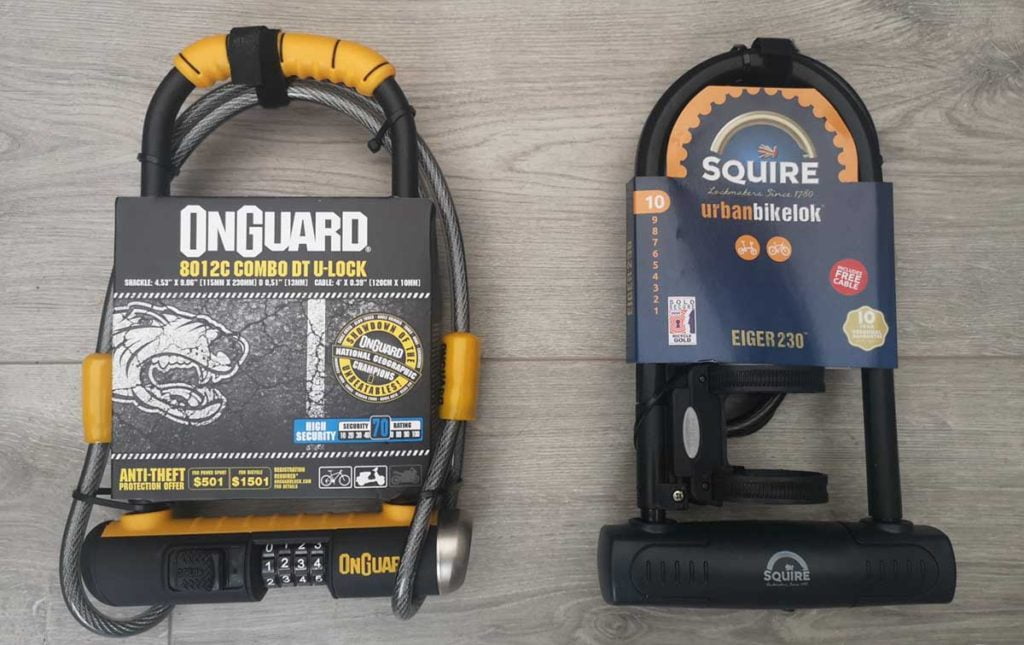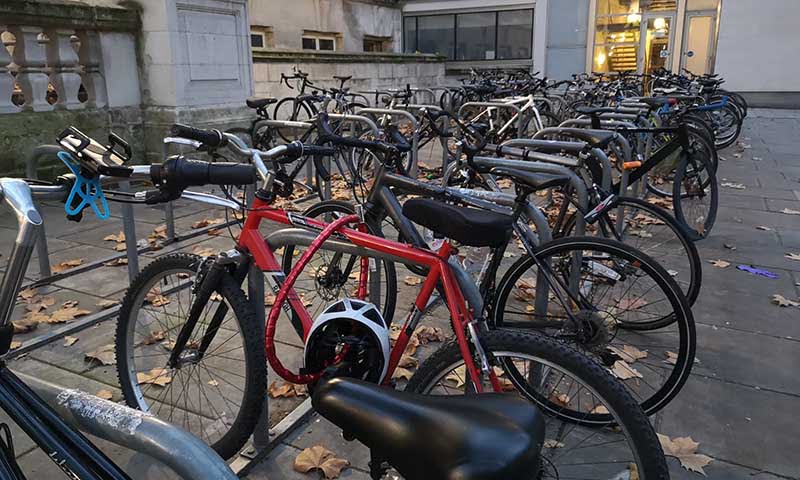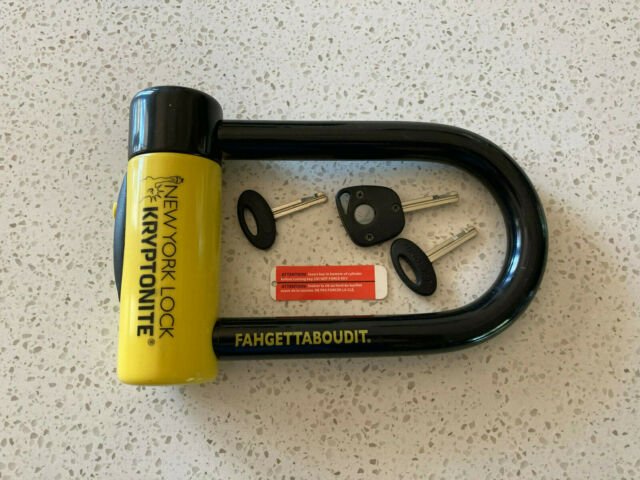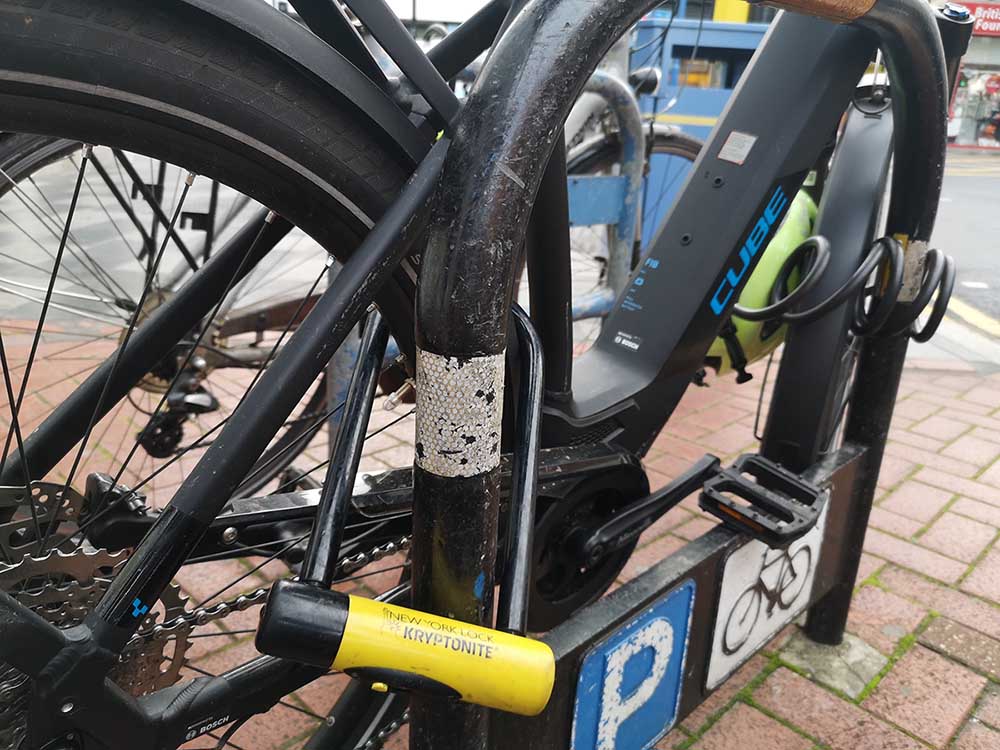Are D-locks the best bicycle locks you can buy?
In a word: probably!
It’s impossible to claim that any locks is “the best” because best is subjective. Is the best the toughest, is it the most portable, is it the best one you can afford?
With so many variables, it’s impossible to claim any one lock is the BEST but there are some that are clearly better than others.
Let’s show you some great D-locks and get you up to speed on how to choose a good one, what you need to spend and how you need to use it.
What is a D-lock?

A D-lock (also known as a U-lock), is a type of lock formed from a stiff metal ring in the shape of the letter D. They are also known as U-locks since the U portion of the lock is attached to a crossbar segment that contains the locking mechanism.
The D-lock works best when the lock is used to attached the bicycle to another item, such as a Sheffield stand, bike rack, or other pole that is firmly planted in the ground.
Simply securing the bike frame to the wheel is not advised because the entire bicycle can still be lifted and transported away even though it cannot be rolled.
Is a D-lock better than a chain?
D-lock, chains, and cables are the three major types of bike locks. The D-lock triumphs in many ways, in terms of its durability, portability dependability, and popularity.
Its mobility and strength to weight ratio are contributing factors to its appeal. A gold standard D lock is much more portable and convenient to carry than a heavy-duty chain and is stronger than a cable lock.
Bicycles are frequently stolen from garages, outbuildings, and garden sheds. If you’re leaving your bike at home unattended or for an extended amount of time, the best security will be provided by a thick chain with a gold or diamond rated D lock (as long as it is fastened to a ground anchor that has the Sold Secure rating).
But when you’re out and about a D-lock is a great bit of security.
A good bicycle D-lock is:
- Portable
- Easy to use
- Unable to be cut with bolt croppers
Those three attributes make them an ideal everyday carry for any cyclist.
Cable locks are no good for out-of-sight security. Chains with padlocks are good but they’re bulky and the thinner ones can be cropped. Folding locks are also a good option but the D-lock is hard to break open by twisting.
The compact nature of a D-lock means that, if fitted properly, makes it hard for thieves access with their tools, let alone bypass.
What is the best bike D lock?
The best way to secure your bike with a D-lock

The D-lock shape has the drawback of not being flexible. It can only fit around an object that is thinner than the ‘U’. Therefore you can’t lock your bike to thicker posts, such as lamp posts.
However, it’s rare that you’ll not have another piece of street furniture or a proper Sheffield stand to be able to lock your bike to.
Some U-locks come with a cable to hold both the frame and the wheels. This is a handy addition but a bolt-cutter would make light work of most of these cables. That’s why it’s important to use your D-lock to lock your bike’s frame to a solid object. Use any additional cable lock to secure the wheels, not just the wheels, to the bike rack.
The diagram above, supplied by Hiplock suggests the best ways to use your lock (or locks) to safely lock your bike.
If you have enough room and a lock with a large enough “U” opening, the best choice is to fasten your frame and a wheel to the rack. To secure all points, wrap the cable around the opposite wheel.
Learning from a bike thief

Respected cycling magazine Cycling Weekly interviewed a serial bicycle thief (who only stopped when he was chased by a helicopter, arrested and sent to jail).
He speaks highly of D-locks as one of the best ways to secure your bicycle from theft.
When asked how he would secure his own bicycle he responded:
“Never use a chain since they can be cut too easily. On both the front and back wheels, use a compact D-lock. If your lock is movable, the thief’s bolt cutters can go around them, but if they are angled correctly, they won’t. Because you require the correct angle on the cutters to generate enough force to close them, stiff D-locks are challenging to snip.”
So there you have it. Straight from a guy who claims to have stolen 10 bicycles every weekend for years.
If you use a D-lock through the seat tube (not the seat post!) and also enclose one of the pedal cranks, you offer hardly any space within the lock itself and you make it much harder for the thief to try and move the lock or the bike to get a better angle from which to attack the lock.
Sold Secure D-locks

Sold Secure’s mission is to evaluate security solutions and offer reliable, qualified advice to business clients, the insurance sector, the home office, law enforcement, and the general public.
In short, they independently test and rate security products and award them a rating, so that it’s easy for us (the consumers) to pick a good product.
There are four different grades that a product can achieve in order to receive the highly sought-after Sold Secure authorised quality label, but it’s vital to note that the grade must be viewed in the context of the test criteria. (For instance, SS101 Motorcycle Gold grading and SS 104 Bicycle Gold grading are not the same.)
The four possible levels of theft resistance for each specification: Bronze, Silver, Gold, and occasionally Diamond. It should be noted that not all standards have all four levels, and Sold Secure frequently adds new testing tiers in response to market need.
Diamond-rated D-locks
Because bicycle D-locks are such an important and popular product within the cycling industry, they are tested to all four standards. So it’s possible to buy a Diamond-rated D-lock, the current highest level but anything that’s Gold-rated is also well up to the job.
To distinguish between locks at the top of the market, the Diamond standard was recently developed. The prior grading system did little to distinguish the better locks as locks have evolved. The best of the best are only allowed in the Diamond class.
However, due to insurers’ tardy response to this new development, you can come across locks that have a dual Gold/Diamond rating, which can look confusing. This icon is shown because, despite a Diamond-rated lock offering greater protection, many insurers still call for a Gold-rated lock.
The lock pictured above is the Kryptonite New York FAHGETTABOUDIT Mini Lock. It’s Diamond-rated by Sold Secure. It is a chunky 18mm thick and takes a serious amount of effort to cut, even with a powered angle grinder. What’s great about it is that any thief would need to cut the lock TWICE in order to free your bike. The metal when cut is still very difficult to bend.
There is a downside to the mini lock though; it’s very small. So it isn’t the perfect ‘take it anywhere, lock it to anything’ lock . The internal dimensions are only 160mm x 80mm but it’ll go around pretty much any conventional bicycle frame and seat stay.
If you want a slightly larger version, Kryptonite also make a “Standard” New York lock, with a slightly thinner 16mm shackle. It gets the Sold Secure Gold (not Diamond) rating. If you were happy to carry two D-locks, then these two provide amazing security and versatility. Thieves will just walk on by.
How Secure Is Your Lock?
Check out this excellent video below. It shows just how easy it is for an experienced thief to take on – and beat – your bicycle security. Hopefully you’ll see that a cable lock is a complete no-no if your bike is going to be out of your sight.
And despite even Sold Secure Gold-rated locks being beaten in this test, the video shows you it’s as much about how you lock your bike and what you lock it with. It’s not just about the rating-level of the security you use when locking your bicycle.
Certain types of locks and applications require different tools which some thieves are not prepared to carry or use in broad daylight.
https://www.youtube.com/watch?v=pywN558dJaU
Bicycle D-Locks Frequently Asked Questions
Are D locks good for bikes?
Yes, they’re strong, portable and relatively light weight. They offer excellent security and a top-rated one can be had for around £50.
Are D locks better than chain?
There’s no definitive answer to this. A chain lock is likely to be heavier and less portable but you can buy chains that are thicker than D-locks. Chains also allow you to lock your bike to a wider range of static objects.
What is the hardest bike lock to break?
Is there a bike lock that cannot be cut?
All locks can eventually be cut but some locks can withstand over 3 minutes of sustained attack from an angle grinder. It is very unlikely that any thief will be able to attack a lock for this period of time without being disturbed or warned off.
Are Kryptonite locks better?
Which type of bike lock is safest?
What is the difference between D lock and U lock?
There’s no difference. The D refers to the shape of the lock with the shackle fitted and the U refers to the shape of the shackle. They are one and the same.
Which locks are most secure?
Are U-locks easy to break?
How much should I spend on a bike lock?
There is no set figure but I advise you spend AT LEAST £50 on a lock, to ensure you’re buying something that will withstand a prolonged attack from the sort of tools that professional bike thieves use. I recommend you buy one excellent D-lock (Sold Secure Diamond rated) or two good D-locks (Sold Secure Gold rated) or a D-lock and a chain lock – depending on your circumstances and parking environment.
Are combination or key bike locks better?
While some blogs reckon that combination locks are liable to ‘picking’ it’s highly unlikely that any thief will try and pick any lock. They can cut a weak lock in seconds with bolt-croppers, so why would they try anything else? If you are the sort of person who regularly misplaces their keys, then a combination lock could be a great solution.
Sources
Thanks to the following websites who helped us to compile this guide to the best bicycle D-locks:
Cycle safety and security – Sustainability (reading.ac.uk)
Bike repair and security | Travel (ox.ac.uk)
